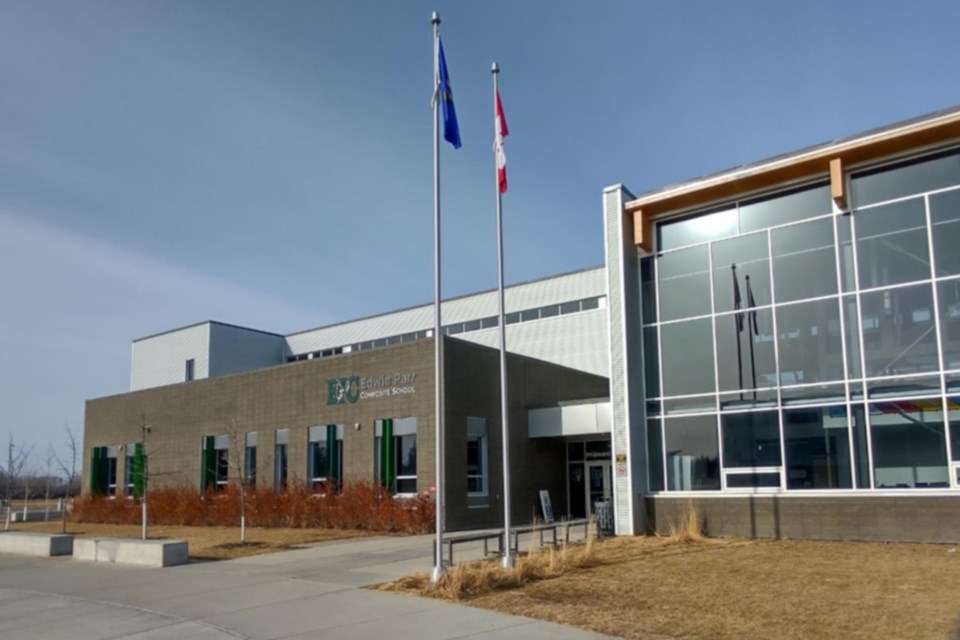ATHABASCA — Aspen View Public Schools (AVPS) trustees are hoping input from industry experts will give the board more insight into the best path forward regarding Edwin Parr Composite’s rooftop solar panel array.
The 780-panel array needs to be removed from the high school’s roof this summer to allow for necessary roof repairs, work trustees were first informed was needed in December 2024.
Related: Future of Athabasca school’s solar panels up in the air
After discussing multiple options in the months that followed, as well as passing and then amending a motion to dispose of the panels this spring, the board is now looking for expert advice to determine the best option for the division and school.
“There’s just so much information coming in and so much uncertainty around it,” said AVPS trustee Dennis MacNeil. “The more information we have, the better the decision-making process could be.”
Supt. Constantine Kastrinos stressed the importance of seeking advice from solar experts versed in commercial and industrial arrays, rather than companies specializing in systems for homes.
“A common error in these situations is extrapolating from a residential situation,” said Kastrinos. “It’s not apples to apples, we’re talking about heavy-duty industrial installation versus residential, it’s a totally different quality.”
Related: Aspen View votes to remove EPC solar array as costs rise
Related: Aspen View trustees reconsider vote to scrap EPC solar panels
During the board’s last meeting of the year on June 19, trustees heard updated numbers and a breakdown of the factors that complicate analyzing the pros and cons of keeping and disposing of the solar system.
“There’s so many different factors when we’re trying to figure out payback and array production,” said Amber Oko, AVPS secretary-treasurer. “We’re trying to use data to make informed decisions, but we do see a lot of variation in the data.”
The new numbers
“We’ve been able to get into a system that does provide the total production to date. Previously, we didn’t have access;” said Oko. “When we were bringing forward Microgen rebate information and trying to use that to work things back and figure it out, it’s because we didn’t have access to full information.”
According to the new data, the panels, installed in 2018, have generated over 1.6 million kilowatt hours (kWh) in six years. Oko said an issue with data collection means no production information is available for the first year of operation.
Averaged out over six years, the panels are producing around 272,000 kWh per year, not far from initial estimations of 284,000 kWh per year. The money earned through rebates over six years, minus what the division pays for electricity for the school, currently sits at $102,000, or an average of $17,000 per year.
This year, the panels have produced 108,000 kWh, resulting in almost $7,000 in rebates, with April through September being the most productive months. But the numbers Oko presented don’t reflect wire charges on the electric bill, which she said are complicated, calculated by using peak demand throughout individual billing periods, as well as throughout the year.
“It’s a very convoluted formula that they use to figure out our monthly wires charges, and trying to back out what portion of that may be related to solar, we just don’t have enough information.”
But to recoup the division’s initial investment of $670,000 into the array, rebates would need to average out to $27,000 in rebates per year over the panel’s 25 year lifespan.
And if trustees opt to spend up to $250,000 more for the removal and reinstallation, the array would need to generate between $33,000 and $37,000 in rebates per year over the lifespan to pay for itself.
These numbers don’t include unexpected expenses for additional repairs or replacements, or changes to safety codes for the system, which Oko warned are costly.
But with the division’s electrical contract coming to an end in December 2025, and electricity rates anticipated to increase, the array could move closer to generating the rebates needed to recoup the extra costs for reinstallation of the panels.
Currently, the division pays just over six cents/kWh. Oko presented trustees with calculations of potential rebates for a range of increased electrical costs, as high as 14 cents/kWh, which would potentially generate around $38,000 in rebates every year.
“(It’s) unlikely, but in this climate, I think it’s really hard to predict where we’ll end up,” said Oko.
Another factor to consider is the fluctuation in rebates received month to month and year to year, said Oko. From August to October in 2021, rebates totalled nearly $7,000. Over the same period in 2022, the division received over $10,000 in rebates, but in 2023, that number dropped to $1,000.
“Even though our use in kWh has remained the same, we’re seeing a drop off in our rebates,” said Oko, pointing to a range of potential factors like environmental or issues with the system itself.
Trustees voted unanimously to direct administration to seek out an area expert in industrial and commercial solar to provide more information to the board.
“As a board, this is a big decision for us,” said chair Candy Nikipelo. “We do appreciate what your departments have gathered for us, but I think we need to go a little over and above that, and that’ll give us the best informed decision.”
The removal of the solar panels is slated for this summer, but exact timing will depend on contractor availability. More information will be provided to trustees in the fall when board meetings resume.



